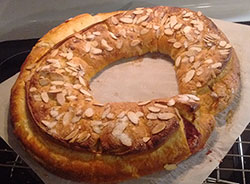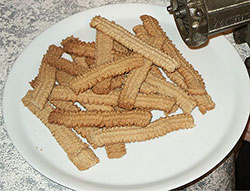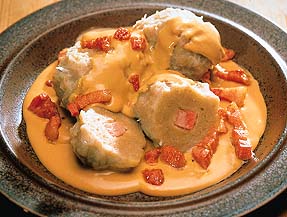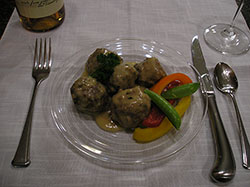Recipes from a Scandinavian-American Family

Larry Gjenvick Makes His Famous Danish Kringle, So Delicious, Incredibly Flaky, A Slice of Heaven on Earth. | GGA Image ID # 1fe4946ac0
The Gjenvick-Gjønvik Family has a great love for food and has many Chefs in the extended family. Among them are Master Chef Svein Magnus GJØNVIK of Trondheim, Norway, and Chef Johann GJENVICK of Milwaukee. We bring you these delightful, tasty culinary dishes from Scandinavia, developed from recipes of generations past for future generations. Cousin of Master Chef Svein Magnus GJØNVIK, Larry GJENVICK of Milwaukee, prepared the Danish Kringle in the photograph above.

Cardamom bread is a delicious sweet taasting cardamom-spiced bread made in a braided style in an oblong pan. Scandinavians often serve cardamom bread with coffee.

This old Danish pastry is legendary. It symbolizes the "hygge," which means "comfortable and good" life. There is a secret to Kringle baking: the dough is made with the butter rolled in -- not mixed or blended with a fork or pastry blender.

Danish Open-Faced Anchovy Sandwiches
The Danish Open-Faced Anchovy Sandwiches have been served every Christmas for as long as I can remember (1950s). The sandwich was the favorite of my Grandfather, who emigrated from Trondheim, Norway, in 1913 to the United States. The sandwiches are easy to make and taste great for those who love the taste of Anchovies.

Fattigmann or Fattigmand Cookies are a tasty treat, often made during the holiday season. Like the Rosettes, these delicious Norwegian cookies are deep fried, so if you're making Rosettes, keep the oil and make some Fattigmann using the same oil.

The Kringla or Spritz Cookie is a family favorite at Christmas. These delicious cookies are easy to make. They are similar in taste to the famous Danish Butter Cookie, so these cookies often disappear quickly.

Krumkaka / Krumkakka / Krumkake Norwegian Cookie Recipe
Krumkake is a delicate but very delicious Norwegian cookie made using batter and a Krumkake Iron. They are made similar to waffles by pouring a tablespoon of batter for each Krumkaka in a krumkake Iron, heating for approximately 30 seconds, and quickly removing the flat krumkaka and rolling them using the particular funnel-shaped molding tools.

Growing up in Minneapolis, lefse was quite common, especially around the holiday season. Many Scandinavians and Scandinavian-Americans purchased lefse at the local grocery store. Still, our tradition was to make lefse at home.

Recipe for a good, old fashioned Norwegian dish

Rice Pudding - Riskrem with Raspberry Sauce
Prepare a traditional Norwegian dessert with this recipe for Riskrem with Raspberry Sauce from the Gjenvick-Gjønvik Archives.

Rommegrot Sweet Cream Porridge
Learn to make this delicious traditional Norwegian holiday recipe for Rømmegrøt (Sweet Cream Porridge) from the GG Archives of Family Recipes.

Rosettes are delicate but incredibly delicious Norwegian (or Swedish) cookies that have been a treat for many generations. They are typically made only during the holidays as they are time-consuming. The original recipe called for deep frying in lard, but we recommend Extra Virgin Olive Oil as an acceptable and healthier substitution.

Swedish Dairy Bake Recipe from the Gjenvick-Gjønvik Archives features hash-brown potatoes, chicken, and broccoli to make a tasty Entrée.

This delightful entree from Sweden has become one of America's favorite dishes. Experience the taste of the Old World in this authentic Swedish Meatball recipe. Traditionally served on Christmas Eve, these meatballs are so good you'll want to fix it year-round.

Using potato flour, this recipe for Swedish Sponge Cake makes a very tender sponge cake baked in a Charlotte russe pan; the center may be removed to leave a hollow shell.

It seems inconsistent at first thought that those who reside in the cooler sections of the country do not indulge to any great extent in the warming influences induced by partaking of that Mexican delicacy Chili Con Carne.

My mom's recipe for Sloppy Joes has been pleasing kids for decades. Simple and easy to make, I looked forward to every time she made this!
Let's Look at the Menu
A traveler visiting Scandinavia for the first time on a summer holiday is almost overwhelmed by the abundance and richness of the food he discovers in the gay, superbly run restaurants and hotels of the capital cities.
If he stays long enough and is welcomed into Scandinavian homes, if he visits country houses, stops at fishing villages, and spends some time with farmers, foresters, and other workers, he will go on being impressed by the excellent food he sees in the clean kitchens and on family tables.
Suppose he is gourmet enough to appreciate the quality, sense the inspiration, and imagination that distinguishes the Northland's cookery. In that case, he will know that this is a superb cuisine.
Remarkable in its traditional allegiance to the ancient French and German court cookery from which much of it has derived, extraordinary in its uniqueness and variety, which developed from the produce of Scandinavia's farmsteads and gardens, grain fields, orchards, and dairies, the wild fruits, game, and seafood and the precious cargoes brought across the oceans in Viking ships.
The traveler, at home again in England or Southern Europe, in America or South America, remembers with particular pleasure the dishes which were characteristic of Scandinavia, those which were native and different, the least like his Yorkshire pudding, or his spaghetti, his Southern fried chicken and California salad bowl, or his chili con carne.
He remembers the astonishing array of appetizers that precede the luncheon or dinner. They resemble each other but wear a different name in each of the four countries: smørrebrød in Denmark, voileipäpöytā in Finland, koldtbord in Norway, smörgåsbord in Sweden.
The gourmet traveler remembers the soups and superlative sauces that smoothly caress the excellent fish dishes, spice the meats and game, dress the vegetables, and add goodness to the decadent desserts. He remembers the flavor of almonds, the leitmotif that runs through the pastries and puddings, and every kind of sweet — almond extract, almond paste, chopped almonds, sliced and whole almonds.
He remembers the fragrant coffee and the many special coffee cakes and breads that appear with this beverage in the morning and again halfway to noon, at luncheon and afternoon coffee, and then in a smaller and sweeter form with the dinner coffee.
His memories are delighted when he recalls the pleasant atmosphere of the luncheon and dinner tables.
The Scandinavians enjoy their food; they want the excuse for food, get together to talk and eat, take a little Aquavit and beer, coffee, and wines, listen to music, dance a little, or dance the night through.
The similarities in the cuisine of the four countries appear as the menus are studied closely, which have developed because of the geographical relationship of the Scandinavian countries and their racial and social interdependence.
The same dishes are found repeatedly in these countries' cuisines, often under names only slightly different in their Danish, Finnish, Norwegian, and Swedish spellings. The true origin and nationality of these dishes have been lost in antiquity.
Recipe terminology and spelling in Scandinavia are highly controversial, even within national boundaries. Different provinces — in the south, the north, near the seacoast, or in some other direction — speak different dialects because of geographical, racial, or class origins; they spell old-style, modern, or everyday.
A recipe fiercely declared original and native to one province, its name spelled a certain way, nevertheless appears in many other parts of the country (and often across the border in neighboring countries) identical to ingredients but with its title written differently.
